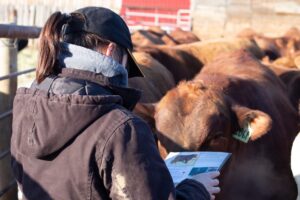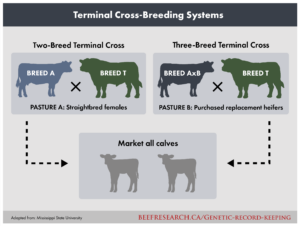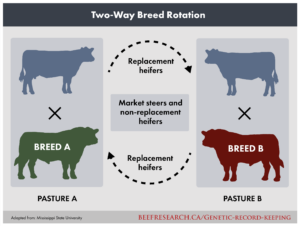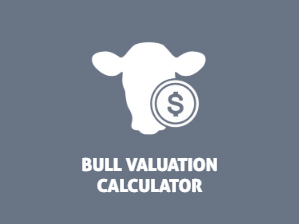Prendre le taureau par les cornes

La saison des ventes de taureaux battra bientôt son plein, ce qui signifie qu’il est temps de déterminer les critères de sélection des taureaux et le budget pour l’achat de prochains taureaux pour votre troupeau.
Sachant que la contribution d’un taureau à la composition génétique d’un troupeau de bovins en une seule saison de reproduction est plus importante que celle d’une vache au cours de sa vie (un taureau peut engendrer 25 veaux ou plus par an alors qu’une vache moyenne produit moins de 10 veaux), la sélection de taureaux génétiquement supérieurs est le moyen le plus rapide d’améliorer la génétique d’un troupeau. Mais comment déterminer quel taureau convient le mieux à votre exploitation ?
Adapter votre programme de sélection à vos objectifs opérationnels
La première étape pour identifier le ou les taureaux qui conviennent à votre exploitation est d’établir clairement les objectifs à long et à court terme de votre exploitation. Ces objectifs, ainsi que les pratiques de gestion et l’infrastructure qui y correspondent, détermineront les programmes de sélection et la génétique nécessaires pour les atteindre.
Il existe une grande variété de programmes de sélection disponibles, et une sélection efficace des taureaux nécessite une compréhension des caractères de votre propre exploitation et de la génétique disponible à l’achat. L’alignement intentionnel de la génétique d’un taureau sur les objectifs de votre exploitation contribuera à l’augmentation des revenus et à la réduction des coûts.
À titre d’exemple, examinons trois scénarios avec des objectifs opérationnels différents et le programme de sélection qui pourrait convenir à chacun d’entre eux :
- George reste propriétaire de tous ses veaux (bouvillons et génisses) jusqu’à l’abattage. Comme il ne conserve pas de génisses de remplacement, un système de croisement terminal est probablement le mieux adapté pour atteindre ses objectifs. Les croisements terminaux à deux ou trois races entraînent une hétérosis de 100 % chez la descendance, ce qui se traduit par des veaux ayant une meilleure performance de croissance.
- Pour les producteurs comme Susan, qui vendent la totalité de leur production de veaux au moment du sevrage, l’augmentation du poids au sevrage est une priorité. Le choix d’un programme de croisement avec une facilité de vêlage élevée et l’avantage supplémentaire de la vigueur hybride serait probablement idéal pour son exploitation.
- Jeff conserve des femelles de remplacement pour son troupeau reproducteur. Pour atteindre son objectif, il pourrait se concentrer sur les croisements afin de développer des croisements F1 qui devraient se traduire par une efficacité reproductive et une longévité accrues. Il peut également se concentrer sur le croisement non apparenté (accouplement avec des animaux non apparentés ou des parents éloignés) au sein d’une seule et même race. Ce système peut être utilisé pour maintenir les niveaux de performance et restaurer les performances perdues en raison d’une dépression due à la consanguinité.
Concentrez-vous sur les caractères qui comptent pour votre exploitation.
Après avoir déterminé vos objectifs opérationnels et vos programmes de sélection, l’étape suivante consiste à évaluer les caractères les plus importantes.
Les écarts prévus dans la descendance (EPD) sont disponibles dans l’industrie du bœuf depuis des décennies et constituent un outil utile pour prendre des décisions de sélection sur les caractères souhaités. Les écarts prévus dans la descendance peuvent être utilisés pour estimer la différence entre la performance moyenne prévue de la future descendance d’un animal et la performance moyenne de la descendance d’un autre taureau. Par exemple, un taureau avec un EPD de poids au sevrage de +60 devrait sevrer des veaux de 20 livres de plus qu’un taureau avec un EPD de poids au sevrage de +40.
Il existe de nombreux EPD, de la facilité de vêlage et du poids au sevrage à la surface du faux-filet et au persillage, en passant par le poids de la vache et la longévité. Les EPD sur lesquels vous vous concentrerez dépendront de vos objectifs opérationnels.
Avec la variété d’EPD disponibles, il peut être difficile de déterminer la contribution d’un troupeau reproducteur potentiel à l’amélioration des caractères qui vous intéressent. En vous concentrant sur les caractères économiquement pertinents (CÉP), vous pouvez limiter votre sélection aux EPD qui comptent le plus pour vos objectifs de sélection.
Les traits économiquement importants sont ceux qui sont directement associés à une source de revenus ou à un coût. Tous les EPD ne représentent pas des CÉP – ils utilisent plutôt un trait connexe (ou indicateur) pour estimer les CÉP. Pour plus d’informations et d’exemples de CÉP par rapport aux traits indicateurs, lisez l’article du blog du BCRC Caractères économiquement pertinents.
Reprenons les scénarios d’exploitation agricole évoqués précédemment :

- Étant donné que George reste propriétaire de tous ses veaux jusqu’à l’abattage et qu’il ne garde pas de femelles de remplacement, l’accent doit être mis sur les taureaux présentant des EPD favorables pour les caractères de la carcasse, telles que le gain après sevrage, le poids de la carcasse, le persillage, la profondeur du gras et la surface du faux-filet.
- L’objectif de Susan étant d’améliorer le poids au sevrage afin de maximiser les bénéfices lors de la vente des veaux au sevrage, il convient de mettre davantage l’accent sur des caractères tels que le poids au sevrage et la facilité de vêlage.
- Puisque Jeff conserve des génisses de remplacement pour son troupeau reproducteur, des caractères comme la facilité de vêlage directe et maternelle ou la longévité devraient être une priorité absolue pour la sélection des taureaux.
En plus des EPD individuels, de nombreuses évaluations génétiques proposent des indices de sélection qui combinent plusieurs caractères en une valeur économique globale pour l’animal. Ces indices sont calculés en plaçant une pondération économique sur les EPD individuels afin de créer un modèle de sélection multi-caractères pour différents types de systèmes de production larges (généralement maternels ou terminaux). La différence entre deux indices d’animaux est la différence de valeur moyenne attendue de leurs veaux.
Connaître son budget taureau avant la vente de taureaux
L’achat d’un taureau est un investissement dans la rentabilité à long terme de votre exploitation. Avec des prix allant de 2 000 $ à plus de 20 000 $ par tête, il est important de s’assurer que votre investissement ajoute de la valeur aux bons endroits tout en respectant votre budget. Différents caractères de taureaux auront un impact différent sur vos résultats. Économiser de l’argent sur un taureau à bas prix peut vous coûter cher à long terme si cela vous éloigne de vos objectifs opérationnels.
Le calculateur d’évaluation des taureaux du BCRC est conçu pour fournir une estimation de la valeur d’un taureau en utilisant des données individuelles de l’exploitation. La valeur du taureau obtenue dans le calculateur n’est qu’une estimation et peut ne pas refléter le véritable prix de vente au seuil de rentabilité. Cependant, cet outil interactif peut être utilisé comme une ligne directrice générale et démontre comment le changement de différentes variables peut affecter le coût ou la valeur d’un taureau reproducteur
Préparer votre troupeau à la réussite
L’achat du meilleur taureau pour les besoins de votre exploitation commence par une bonne tenue des registres afin d’identifier les forces et les faiblesses de votre exploitation. Recueillez et analysez régulièrement des données pour suivre les performances de votre troupeau. Cela vous aidera à prendre des décisions éclairées en matière de reproduction et à suivre les progrès de votre troupeau au fil du temps.
Le choix d’un taureau est l’une des décisions les plus importantes que vous, l’éleveur vache-veau, prendrez cette année et qui est vitale pour le succès de votre exploitation. À l’approche de la saison de reproduction, c’est une excellente occasion d’évaluer les objectifs de votre exploitation et d’élaborer un plan pour les atteindre.
Le partage ou la réimpression des publications du BCRC sont les bienvenus et sont encouragés. Veuillez mentionner le Beef Cattle Research Council, fournir l’adresse du site Web, www.BeefResearch.ca, et nous faire savoir que vous avez choisi de partager l’article en nous envoyant un courriel à info@beefresearch.ca.
Vos questions, commentaires et suggestions sont les bienvenus. Contactez-nous directement ou lancez une discussion publique en publiant vos idées ci-dessous.


